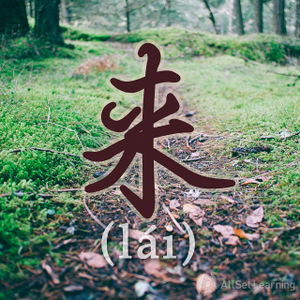Difference between revisions of "Advanced uses of direction complement "-qilai""
| Line 34: | Line 34: | ||
*如果 你 <strong>把</strong> 工作 和 兴趣 <strong>结合</strong> <em>起来</em>,工作 就 会 很 快乐 。<span class="pinyin">Rúguǒ nǐ <strong>bǎ</strong> gōngzuò hé xìngqù <strong>jiéhé</strong> <em>qǐlái</em>, gōngzuò jiù huì hěn kuài lè.</span><span class="trans"> If you combine your work with your interest, working would be fun.</span> | *如果 你 <strong>把</strong> 工作 和 兴趣 <strong>结合</strong> <em>起来</em>,工作 就 会 很 快乐 。<span class="pinyin">Rúguǒ nǐ <strong>bǎ</strong> gōngzuò hé xìngqù <strong>jiéhé</strong> <em>qǐlái</em>, gōngzuò jiù huì hěn kuài lè.</span><span class="trans"> If you combine your work with your interest, working would be fun.</span> | ||
*我们 要 <strong>把</strong> 所有 的 资源 都 <strong>利用</strong> <em> 起来</em>。<span class="pinyin">Wǒmen yào <strong>bǎ</strong> suǒyǒu de zīyuán dōu <strong>lìyòng</strong> <em> qǐlái</em>.</span><span class="trans">We need to put all the resources together.</span> | *我们 要 <strong>把</strong> 所有 的 资源 都 <strong>利用</strong> <em> 起来</em>。<span class="pinyin">Wǒmen yào <strong>bǎ</strong> suǒyǒu de zīyuán dōu <strong>lìyòng</strong> <em> qǐlái</em>.</span><span class="trans">We need to put all the resources together.</span> | ||
| − | *如果 你 能 <strong>回忆</strong> <em>起来</em> 这件 事情,就 好 了。 | + | *如果 你 能 <strong>回忆</strong> <em>起来</em> 这件 事情,就 好 了。<span class="pinyin">Rúguǒ nǐ néng huíyì qǐlái zhè jiàn shìqing, jiù hǎo le.</span><span class="trans">It would be good if you could recall this incident.</span> |
| − | *她 最近 很不 开心,我 怎么样 才能 让 她 <strong>高兴</strong> <em>起来</em> 呢? | + | *她 最近 很不 开心,我 怎么样 才能 让 她 <strong>高兴</strong> <em>起来</em> 呢?<span class="pinyin">Tā zuìjìn hěn bù kāixīn, wǒ zěnmeyàng cáinéng ràng tā gāoxìng qǐlái ne?</span><span class="trans">She's been very unhappy lately. How can I make her happy?</span> |
</div> | </div> | ||
Revision as of 07:05, 22 October 2020
-
Level
-
Similar to
-
Used for
-
Keywords
We saw in B1 that 起来 (qǐlái), among other things, can be used to express a literal upward movement. 起来 also has some more slightly less intuitive usages, which are figurative extensions of the "movement" idea.
起来 can be used to express collecting things together, where in English we might say "tidy up," or "add up."
Structure
Verb + 起来
Note that you will often see this pattern used with 把 sentence.
Subj. + 把 + Obj. + Verb + 起来
Examples
- 13 和 15 加 起来 是 多少 ?How much is 13 and 15 added up?
- 他 把 衣服 都 收 起来 了 。He put away his clothes.
- 我 老婆 把 钱 都 存 起来 了 。My wife saves up all our money.
- 把 你 的 玩具 都 收 起来 。Put your toys away.
- 你 为什么 要 把 我 的 手机 藏 起来 ?Why would you hide my cell phone?
起来 can also be used to express more abstract concepts of bringing things together.
- 如果 我们 团结 起来 ,一定 能 赢 。We will absolutely win this if we unite.
- 如果 你 把 工作 和 兴趣 结合 起来,工作 就 会 很 快乐 。 If you combine your work with your interest, working would be fun.
- 我们 要 把 所有 的 资源 都 利用 起来。We need to put all the resources together.
- 如果 你 能 回忆 起来 这件 事情,就 好 了。It would be good if you could recall this incident.
- 她 最近 很不 开心,我 怎么样 才能 让 她 高兴 起来 呢?She's been very unhappy lately. How can I make her happy?
See also
- Result complement "-qilai"
- Figurative directional complements 下去 and 出来
- Direction complement
- Result complements "dao" and "jian"
- Appearance with "kanqilai"
Sources and further reading
Books
- HSK Standard Course 4下 (pp. 135) Anything Goes (无所不谈) →buy
- Boya Chinese Elementary Starter 2 (博雅汉语初经起步篇) (pp. 80) Anything Goes (无所不谈) →buy
- Chinese Grammar - Broken down into 100 items - Basic and Intermediate Levels (汉语语法百项讲练 - 初中级) (pp. 25-31) Anything Goes (无所不谈) →buy
- Integrated Chinese: Level 1, Part 2 (3rd ed) (pp. 141-2) Anything Goes (无所不谈) →buy
- Integrated Chinese: Level 2, Part 1 (pp. 342-3) Anything Goes (无所不谈) →buy
- Integrated Chinese: Level 2, Part 2 (pp. 20) Anything Goes (无所不谈) →buy
- New Practical Chinese Reader 3 (新实用汉语课本3) (pp. 169) Anything Goes (无所不谈) →buy
- New Practical Chinese Reader 5 (新实用汉语课本5) (pp. 134-5) Anything Goes (无所不谈) →buy



